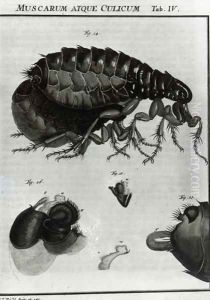Johannes Augustin Rosel von Rosenhof Paintings
Johannes Augustin Rösel von Rosenhof was a prominent figure in the realm of natural history and art during the early to mid-18th century. Born in 1705 in Germany, Rösel von Rosenhof embarked on a career that beautifully melded his passion for art and his keen interest in the natural world. His contributions are particularly notable in the field of entomology, where his detailed and vivid illustrations of insects and plants have earned him a lasting place in the annals of scientific illustration.
Rösel von Rosenhof’s work is characterized by its meticulous attention to detail and its artistic finesse. He was not only a talented painter but also an astute observer of nature, qualities that are evident in his most renowned work, the 'Insecten-Belustigung' (Insect Entertainment). Published in several volumes beginning in 1740, this work was groundbreaking in its detailed depiction of the life cycles of various insects, contributing significantly to the field of entomology at a time when the study of insects was still in its infancy. Each plate in his volumes is a testament to Rösel von Rosenhof’s skill in combining scientific accuracy with artistic beauty, making his work a valuable resource for both scientists and art enthusiasts.
Aside from his contributions to entomology, Rösel von Rosenhof was also involved in the broader European intellectual and artistic movements of his time. He was part of the Enlightenment, a period that valued reason, science, and an appreciation for the natural world, which is reflected in his works. Despite his significant contributions to the natural sciences and art, Rösel von Rosenhof's name is not as widely recognized as some of his contemporaries. However, his work continues to be appreciated for its contribution to the early scientific study of insects and its artistry.
Johannes Augustin Rösel von Rosenhof passed away in 1759, but his legacy lives on through his influential works. His dedication to illustrating the natural world in such a detailed and beautiful manner helped pave the way for future generations of naturalists and scientific illustrators. His work remains a prime example of how art and science can intersect to enhance our understanding of the natural world.
